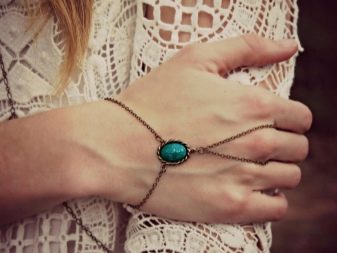Indian bracelets

Indian bracelets cannot be called jewelry in the literal sense of the word. And although most of these jewelry are made of glass, metal or wood, they are created by experienced jewelers and embody the ancient customs of the eastern world.



Peculiarities
Girls in India are taught a sense of aesthetics from birth. Therefore, it will not be difficult to understand what bright clothes, fresh flowers in her hair and numerous jewelry mean for a girl. It is, first of all, the pursuit of the expression of beauty.
Indian bracelets are not always worn on the arm; a set of bracelets worn on the ankle of the foot looks quite original. It is believed that such accessories, due to the light ringing, scared off snakes.
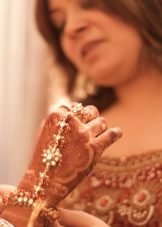



Indian style jewelry is created according to local customs. For example, it is customary for some peoples to wear bracelets, completely covering the arm from the wrist to the forearm. Another common option is a wrist jewelry with a ring, when richly decorated chain threads stretch from the hand to one or more fingers.


Wearing bracelets in India is considered not just a tribute to beauty and fashion trends, but also an integral part of a ritual, for example, a wedding. After the wedding, the woman assumed the obligation to wear bracelets on her wrist. But even in this case, she was obliged to follow local customs. For some nationalities, it was customary to combine gold and glass jewelry on hand.
It was believed that such a set would allow the husband and sons to achieve well-being. Glass bracelets were forbidden for widows.



In other parts of the country, it was believed that jewelry should not be taken off for a minute, so when changing sets of bracelets, they wore metal wire or wrapped a brush with the hem of their clothes.

Properties
Hindus believe that their jewelry is not just a cultural property, but also carries healing and magical properties:
- activate the brain;
- allow you to resist hypnosis;
- relieve the pain of a woman in labor;
- help to draw energy from the bowels of the earth (therefore, it is recommended to wear bracelets made of silver on your feet);
- endow with wisdom and knowledge;
- depending on the place of contact with the body, the color of the inserts and the metal, bracelets can bring a positive effect to the owner or affect her negatively.



Models
Modern bracelets in Indian style are made of precious metals, decorated with enamel, skillful filigree, wooden elements, jewelry resin, may have inserts with natural stones or semiprecious minerals.
The shapes of the products can be the most incredible: from a simple thin bezel to luxurious models with numerous precious inlays crowned with the head of a bird or an animal.
The main thing in the accessory is the symmetry of all the details.





Indian foot bracelets are at the height of fashion, known by names such as "payaly" or "jangar". Previously, leg jewelry was connected with a chain, so the girl's step became short and light. Today this tradition has receded into the background. Now these are ordinary bracelets made of precious metals, decorated with multi-colored beads, dangling chains and small bells.



Models can be heavy, made in the original ethnic tradition, or they can be thin and light, and even represent just a black thread with beads. The first version of jewelry is in better harmony with national clothes, and the second (imitative) fits more into European youth images: casual jeans, blouses, skirts, dresses. But even narrow bracelets have magical properties: they protect from the evil eye.
Interestingly, in some states of India, ankle ornaments are made exclusively from silver alloys. Gold is considered a noble metal, so wearing it on your feet is discouraged. Depending on the materials and inserts, the prices for foot accessories range from a few dollars to several thousand.


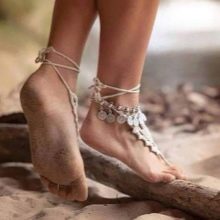
In Indian culture, almost everything has a symbolic meaning. Of course, jewelry is no exception. Mostly on the decorations, you can see floral ornaments or images of animals. It is believed that wearing a bracelet with a particular pattern strengthens certain qualities in a person:
- jasmine - fertility;
- ficus - prosperity, wealth, luxury;
- elephant - confidence, reliability;
- lion - strength, freedom;
- peacock - beauty, love;
- snake - courage, courage, new beginnings;
- fish - well-being.
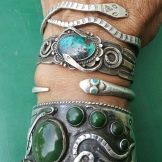
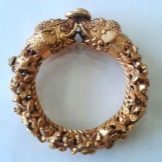

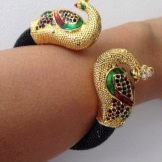
The floral ornament allows you to combine the traditions of the classics and trends of modern jewelry art, therefore, Indian bracelets are perfectly combined with the traditional costumes of their country, and with European evening dresses (including little black ones), and with the urban everyday style of clothing (T-shirts, jeans, sneakers).
You can give preference to wide models or wear several thin headbands at the same time, as well as complement the image with a necklace of a similar pattern.

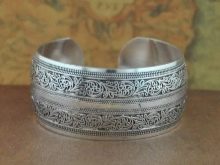

Color solutions
All colors used in bracelets have their own symbolic meaning:
- orange - success in endeavors;
- red - strength, energy;
- yellow - happiness;
- gold - a happy and prosperous life;
- white - new opportunities;
- silver - a manifestation of strength;
- blue - serenity, wisdom;
- black - power;
- green - expectation of change, wedding;
- purple - independence.


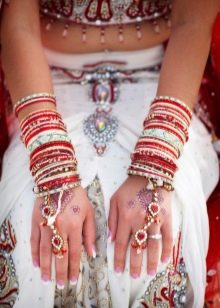


How to wear?
In India, there are special traditions of wearing bracelets, which vary greatly depending on the characteristics of a particular area. The vast majority of women in the country wear gold wrist jewelry, and in eastern West Bengal, married women are required to adorn themselves with red and white coral bracelets to highlight their marital status.
In Punjab, girls wear ivory accessories for a year after their wedding. In Rajasthan, women cover their entire arm with gold bracelets, from wrist to forearm. In a similar way, jewelry is worn throughout life or while the spouse is alive.
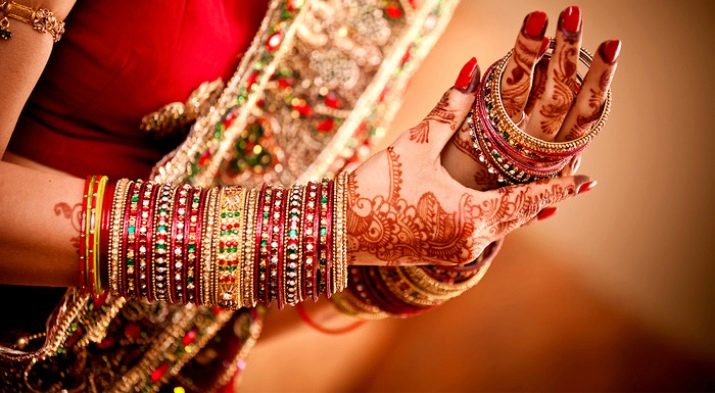
Now Indian traditions have become less strict, so women can afford to wear bracelets of different styles, regardless of their social status and any life events. Although each family and area has its own rules for wearing jewelry.
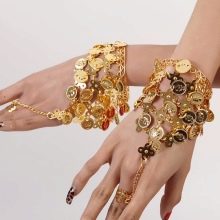


There is an Indian tradition called the "bracelet ceremony" which girls still observe today. When a woman is expecting a baby, her hands are decorated with numerous bracelets that emit a slight ringing.
It is believed that in this way you can distract their attention and protect the baby from danger.

When to wear?
Indian bracelets can be worn on hands and feet at the same time, used as accessories for ceremonies or jewelry curiosities "for every day" (work, walk, shopping). Such decoration will certainly revive and diversify the classic look, as well as add dynamism and color to your everyday outfit.



There are rules for wearing Indian bracelets depending on the season. In warm and hot seasons, you should not wear bright and heavy models. It is better to choose graceful silver bracelets with stones of delicate shades. Massive items adorned with large precious stones are an option for the cold season.

